Ever wondered what goes into the making of an indie sci-fi film?
Director, producer, and VFX supervisor Hasraf (HaZ) Dulull gave us a glimpse behind the scenes of his recent sci-fi film THE BEYOND. Loosely based on Dulull’s indie sci-fi short film PROJECT KRONOS, which was optioned but never made, THE BEYOND showcases Dulull’s fascination with technology’s underbelly as well as the hope it offers.
Here, Dulull shares what it was like directing his first feature-length film.
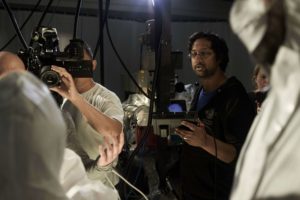
HaZ on the set of THE BEYOND
On how PROJECT KRONOS turned into THE BEYOND
The journey from optioned piece to finished film is notoriously bumpy. Many optioned projects never make it to the big screen, for many reasons. In the case of PROJECT KRONOS, a lot had to do with the time involved.
“I worked on the feature film development of PROJECT KRONOS for several years,” says Dulull. “This was great, as I learned so much from working with the executives and producers. But as with a lot of film development, you can sometimes go though a cycle of years of development. I didn’t have the patience for that.”
Another challenge—being a first-time director in the eyes of many people. “Studios were not keen on taking risks with someone who just had done short films,” Dulull explains.
Ultimately, Dulull decided not to re-option the project. Instead, he turned into an indie film. “I took back the rights and redeveloped it. I spent a year on the script and then raised the finances personally, gathered a team, mostly talented people I had worked with on my short films.”
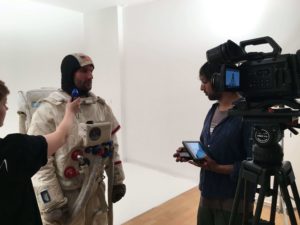
A look at the white room where a lot of the initial shots were captured
On selecting the style for the film
“THE BEYOND is presented in a raw, grounded, voyeuristic style, often seen in modern documentary films,” says Dulull. “The candid interview-style and the fly-on-the-wall approach to capturing the performances was a way for me to present the format with realism while being set against a sci-fi background of advanced technology and space exploration.
“Scenes throughout the film are designed to give the impression that its constructed from multiple sources (similar to the ‘found footage’ genre but pushed to another level). Not only does this style reduce budgets, but it also allowed me to be clever on how to frame the shots—creatively putting the audience right into the action and its environment, leading to a more intimate experience with the characters and story.
“Above all, it kept the whole film as grounded as possible.”
On making sci-fi VFX on an indie budget
Both budget and stylistic approach can make VFX tricky—and it was no different with THE BEYOND, says Dulull. His aim was to push boundaries and focus on scientific themes, while still satisfying the expectations of today’s moviegoers.
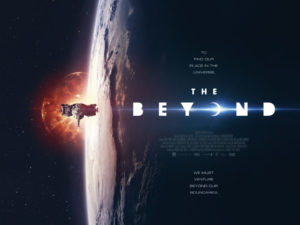 “One cheat was to use various CGI techniques and front digital projection to play back into the camera to create a documentary, voyeuristic look, as opposed to flashy, glossy CGI seen in superhero films,” Dulull says.
“One cheat was to use various CGI techniques and front digital projection to play back into the camera to create a documentary, voyeuristic look, as opposed to flashy, glossy CGI seen in superhero films,” Dulull says.
“Although I handled a big portion of the VFX myself, I enlisted the help of two VFX facilities—Filmmore and Squint VFX—as well as a team of trusted VFX ninjas I have collaborated with in the past, including John Sellings, Aleksandr Uusmees, Andrea Tedeschi, and a lovely team in Malaysia too.
“Things like the Human 2.0, I sent out to the two VFX facilities, which had a lot of animation and CGI rendering capabilities. I handled things like compositing all the space shots and the spheres.” By planning ahead, Dulull says, he was able to handle a lot of the VFX during filming and editing, rather than in post-production.
On the challenges of the Human 2.0 scenes
Dulull says, “The Human 2.0 scenes were the most challenging because they had to look photo-real. We tried to do it in camera using a built suit, but it wasn’t achieving the look we wanted, and the actors felt uncomfortable in the suit.
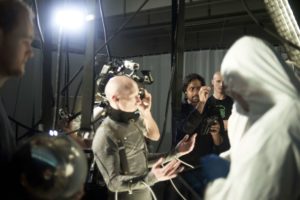
The grey motion suit worn by actors on set
“So, we went with a full digital solution. The actors wore a tight grey suit with tracking markers on. We restricted our camera moves for simplicity’s sake to enable object tracking to work as accurately as possible.
“We also shot multiple reference footage from all angles to help with match moving. Having a tracking supervisor on set helped massively and allowed us to make this happen within the budget, while still making it all look and feel real.
Our biggest issue came when our actress made very tiny movements due to breathing in close-up shots. Because our Human 2.0 was human consciousness in a synthetic shell, breathing didn’t make sense. We began making up for it by freezing the image or doing some stabilization, which ended up being nearly impossible for the very close-up shots.
“In the end, I had to think outside the box — so I wrote a few lines into the script that explained the Human 2.0 was breathing to make it psychologically more acceptable to other humans. Those two lines saved us weeks and possibly months of time.”
On how it feels to see the final product
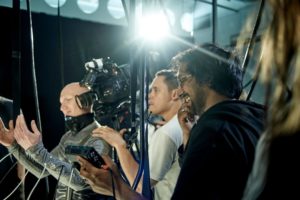
Haz and his team on set
“I am very pleased with the way the film came out, mostly due to the amazing team of collaborators I had—many who worked with me on my short films previously,” says Dulull.
“The big thing I’m pleased with is that the film has a positive message about humanity as opposed to a cliched one. And also, it has caused audiences around the world to discuss it.”
On where to see THE BEYOND
The Beyond was picked up for distribution by Gravitas Ventures and had a worldwide release early this year.
It’s currently available on most digital streaming platforms, such as iTunes, Amazon Video, Youtube Movies, Vimeo on Demand, Google Play, and many more.
For access directly to these platforms, please visit THE BEYOND on HazFilm.com. You can also view a free 30-minute documentary on the making of THE BEYOND on Vimeo.